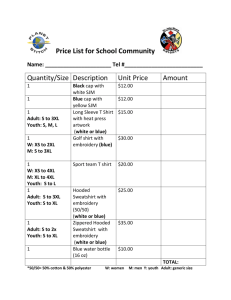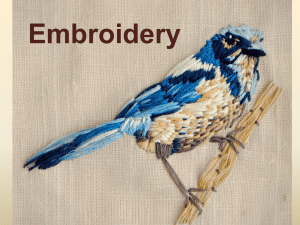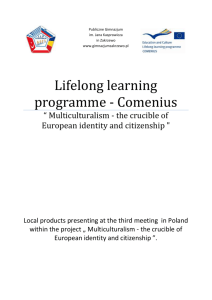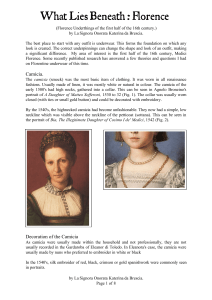What Lies Beneath : Florence Camicia 1540-1560
advertisement
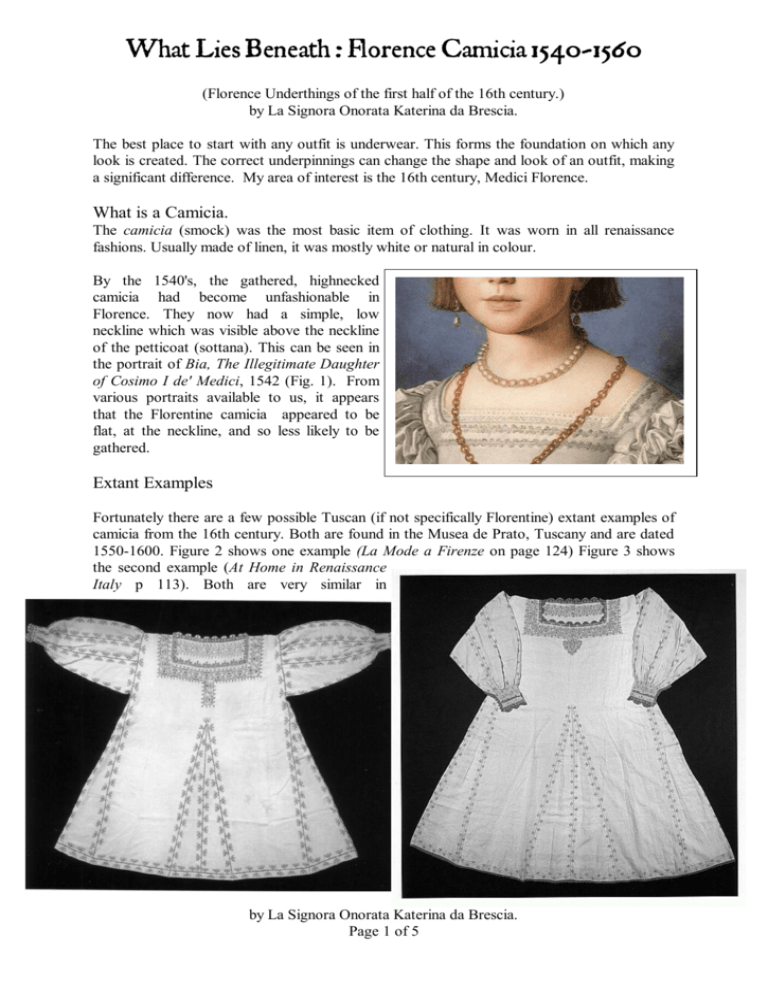
What Lies Beneath : Florence Camicia 1540-1560 (Florence Underthings of the first half of the 16th century.) by La Signora Onorata Katerina da Brescia. The best place to start with any outfit is underwear. This forms the foundation on which any look is created. The correct underpinnings can change the shape and look of an outfit, making a significant difference. My area of interest is the 16th century, Medici Florence. What is a Camicia. The camicia (smock) was the most basic item of clothing. It was worn in all renaissance fashions. Usually made of linen, it was mostly white or natural in colour. By the 1540's, the gathered, highnecked camicia had become unfashionable in Florence. They now had a simple, low neckline which was visible above the neckline of the petticoat (sottana). This can be seen in the portrait of Bia, The Illegitimate Daughter of Cosimo I de' Medici, 1542 (Fig. 1). From various portraits available to us, it appears that the Florentine camicia appeared to be flat, at the neckline, and so less likely to be gathered. Extant Examples Fortunately there are a few possible Tuscan (if not specifically Florentine) extant examples of camicia from the 16th century. Both are found in the Musea de Prato, Tuscany and are dated 1550-1600. Figure 2 shows one example (La Mode a Firenze on page 124) Figure 3 shows the second example (At Home in Renaissance Italy p 113). Both are very similar in by La Signora Onorata Katerina da Brescia. Page 1 of 5 What Lies Beneath : Florence Camicia 1540-1560 appearance to each other, with a flat neckline, voluminous sleeves and gussets in the centre front (the back is not visible) and the sides. These differ from the extant 16th century 'Italian' camicia found in the V&A Museum and the Sicilian camicia (under Spanish rule in 16th C), which both have a gathered neck. Another possible Tuscan extant item of interest is a shirt, also dated at 1550-1600 (Figure 4, At Home in Renaissance italy p 182). Though a male shirt with a high, gathered neck and straighter body, it is interesting to see the similarity in the sleeve construction. The sleeve appears to be made from a rectangle of linen which is gathered at the cuff, in either long, narrow cartridge pleating. This is similar to the construction of the sleeves in the two extant female camicia. Patterns for Tuscan Camicia. Based on these extant Tuscan camicia, I propose the following pattern for a Florentine camicia of the 1540-1560 (Figure 5). This pattern is comprised of a rectangular front and back, rectangular sleeves, 4 triangular side gussets and four, smaller triangular gussets (2 visible at the front and 2 assumed to match in the back.). If you look at portraits available, such as Figure 1 and Bronzino's portrait of Maria de Medici, in Figure 7. This would mean creating the 'square' neckline so it appears possibly 2-3 cm above the proposed sottana neckline. The side gussets start under the arm and extent the length of the by La Signora Onorata Katerina da Brescia. Page 2 of 5 What Lies Beneath : Florence Camicia 1540-1560 camicia. The front body gussets start at the waistline in one extant example, and higher up in the second. This positioning would depend on the shape of the wearer, and snugness of fit. Decoration of the Camicia As camicia were usually made within the household and not professionally, they are not usually recorded in the Gardaroba of Eleanor di Toledo. (LMF p125) In Eleanora's case, the camicia were usually made by nuns who preferred to embroider in white or black. (LMF p126) In portraits from 1540-1560s, we usually only get a glimpse of the camicia near the neck, the cuff or occasionally through slashes in sleeves. From these we can glimpse bits of embroidery. Silk embroidery of red, black, crimson or gold spanishwork were commonly seen. Other forms of camicia decoration, throughout the middle of the 16th century, were drawn thread work (Fig. 1), lace, silk and gold embroidery. (la Mode a Firenze, p124). An example of elaborate camicia embroidery, in gold and black silk, can be found in another portrait of Maria de Medici by Bronzino from 1551. (Figure 6). For the state, Eleanora was officially the epitome of Modesty by wearing her 'official' dress. In her private life she was not the most modest of Florentine women. She enjoyed riding, fishing and hunting with her husband Cosimo. These outfits do not make it to portraiture, so we must console ourselves with the written word, portraits of others and the very few extant camicia available to us. There were only 18 various camicia actually recorded in the Gardaroba of Eleanora. (LMF p 126). Recorded decorations in the middle of the 16th century, include embroidery of gold, pearls and silk. (La Mode a Firenze, p 124). Though there are written accounts of this type of embroidery being worn by Eleanora, her official portraits were always more of more simple camicia. Available pictorial examples of this more elaborate embroidery are found in portraits of her son Don Garcia's collar, 1550 (Figure 7, by Bronzino) and the gorgiera (partlet) of her daughter Maria, 1555 (Figure 5, by Allori). From this, we can surmise the type of embroidery that was present on Eleanora's camicia., which could be more constistent with the written word. by La Signora Onorata Katerina da Brescia. Page 3 of 5 What Lies Beneath : Florence Camicia 1540-1560 Existing examples of camicia decoration can be seen in Figures 3, 4 and 5. All can be in found in the Musea de Prato in Tuscany and is dated at 1550- 1600. 'Rust' coloured embroidery is seen on the neckline, sleeves, cuffs and cross-stitched decoratively over the seams of Figures 2 and 3. This could be red or iron based, black embroidery that has 'rusted'. I do not have more information on any chemical analysis. Figure 4 has cross-stitch embroidery. Figure 4 appears to have a running (Holbein) stitch for decoration, as does Figure 5 an example of a man's shirt. Stitching appears to be of blue colour. The general positioning of the decoratoin is the same in all three examples. There is a band of embroidery around the neckline and down the centre front. Embroidery can be seen covering the seams of the sides, gussets and hem. There is also 6 verticle lines running down each sleeve and around the cuff. Lace is also seen around the neckline, cuffs and hem. Bibliography: 1. Ajmar-Wollheim, Marta & Dennis, Flora (ed). At Home in Renaissance Italy. V&A Publications London, 2006. ISBN: 10 1 85177 488 2. 2. Anderson, Ruth Mathilde. Hispanic Costuming 1480-1520 p 215 (info supplied by Mistress Constanzia de Zamora via email list - thanks)* 3. Arnold Janet, Queen Elizabeth's Wardrobe Unlock'd, Maney, Leeds, 1988, ISBN:0901286-20-6 4. Arnold, Janet. Patterns of Fashion. Macmillan, 1985. London. ISBN: 0-333-38284-6 5. Kovesi Killerby, Catherine, Sumptuary Law in Italy 1200-1500, Oxford University Press. NY. 2002. ISBN:0-19-924793-5 6. Carole Collier. Dressing Renaissance Florence.: Families Fortunes & Clothing. John Hopkins University Press. Baltimore. 2002. ISBN: 0-8018-6939-0 7. Mikhaila, Ninya & Malcolm-Davies, Jane. The Tudor Tailor. BT Batsford.London. 2006 ISBN:0 7134 8985 5 8. Orsi Landini, Roberta & Niccoli, Bruna. Moda a Fioenze 1540-1580. Pagliai Polistampa, Firenze, 2005. ISBN: 88-8304-867-9 9. Willet, C. & Cunnington, Phillis, A History of Underclothes, Dover Publications, NY, 1992, ISBN: 0-486-27124-2 Fennel Mazzoui, Maureen. by La Signora Onorata Katerina da Brescia. Page 4 of 5 What Lies Beneath : Florence Camicia 1540-1560 10.Veccellio, Cesare. Vecellio's renaissance Costume Book. Dover Publications. NY. 1977. ISBN: 0 48623441X Willet, C. & Cunnington, Phillis, A History of Underclothes, Dover Publications, NY, 1992, ISBN: 0-486-27124-2 Web Sites: 11. V&A Museum website: http://images.vam.ac.uk V&A web site: http://www.vam.ac.uk/ (May, 2004) 12. Bath Museum of Costume: http://www.museumofcostume.co.uk/ http://www.museumofcostume.co.uk/index.cfm?fuseAction=SM.nav&UUID=013DFA1432A6-4A33-B3CDA4E8E00C9D49) 13. National Gallery of Art, Washington http://www.nga.gov/ 14. Web gallery of Art. http://www.wga.hu/ 15. www.goldsword.com - Gallery 16. WebMuseum, Paris. ( http://www.ibiblio.org/wm/paint/auth/bronzino/garcia.jpg ) 17. Warwickshire Museum Website www.datavista.co.uk 18. Diversarum nationum habitus http://www.istitutodatini.it/biblio/images/riccard/12886/htm/vol1.htm 19. Oonagh's Own: http://oonagh.actewagl.net.au/ 20. Elizabethan Costume Page http://costume.dm.net/bath/bathsmock1front.jpg 21. V&A web site: http://www.vam.ac.uk/ (May, 2004) 22. Archeological Sewing by Heather Rose Jones (2001) www.virtue.to/guest_authors/archaeological_sewing.html (5/04) by La Signora Onorata Katerina da Brescia. Page 5 of 5


